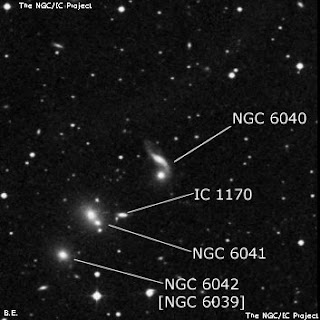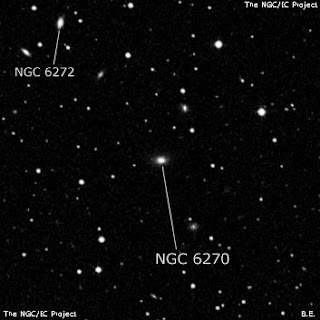ABELL 2197
eg 6138: 0'.9 x 0'.2: Vis. 14.7; SB 12.7: Very difficult to see, it was elusive and only glimpsed on occasion with averted vision. The faint, oval slash was seen at 187x, 200x, and 250x.
http://www.ngcicproject.org
eg 6145: 0'.8 x 0'.4: Vis. 14.2; SB 12.8: Spread over 2 nights in late Spring 2014. 46 is easy
eg 6146: 1'.3 x 1'.1: Vis. 12.5; SB 12.8: to view at 100x, preceding a faint star. It was oval and
eg 6147: 0'.4 x 0'.4: Vis. 15.1; SB 13: bright even up to 200x. Many bright stars are in the field, as well as6145. Spotted at 125x and viewed up to 200x, it was best at 150x. Averted vision shows a pretty big object. Due to deteriorating conditions on the first night, I was unable to locate 6147. However, the next observable night was much better, and it was spotted at 187x. It was small, though sometimes flaring into 6145 and almost seeming as one object. It is extremely faint and pretty difficult to see. Wait for the best conditions.
http://www.ngcicproject.org
http://www.ngcicproject.org
UGC 10407: 0'.7 x 0'.6: Vis. 13.7; SB 12.7: Both galaxies are in the north of Abell 2197.
UGC 10415: 0'.9 x 0'.8: Vis. 13.8; SB 13.3: Though brighter than some of the recent NGC objects, they are not bright. 407 is much easier to view. Both are round. 415 appears not only fainter, but smaller. However, it did show a brighter middle. Best views of the pair together were with averted vision at 150x.
eg 6173: 1'.9 x 1'.4: Vis. 12.1; SB 13.2: It appears very large and bright at 150x. It can best be seen at 187x, once the mag. 7 double star was out of the field of view. This is the brightest galaxy in Abell 2197, and 2nd brightest on Chart A-3. It was slightly oval and had a notable and large bright middle.
http://www.ngcicproject.org
eg 6174: 0'.4 x 0'.4: Vis. 14.5; SB 12.5: This one is tricky. However, since it lies just north of 6173, ti proved doable. it wa tiny, almost stellar, and faint. It was seen at 187x and 200x.
eg 6175: 1'.3 x 0'.8: Vis. 13.7; SB 13.6: Located at 100x, though best at 187x. It was elongated. It is south preceding the 7 mag. star near 6173, which lies just north of this galaxy. All of the galaxies in Abell 2197 (except the first one) were located by star-hopping from 6146. That one has served as home base for my explorations. 75 has a bright middle.
http://www.ngcicproject.org
eg 6180: 0'.9 x 0'.6: Vis. 14.1; SB 13.5: I was pleasantly surpised when this galaxy was located without much fuss, though it took 150x to confirm it. It was seen well at 187x, displaying a bright middle.
http://www.ngcicproject.org
eg 6184: 0'.8 x 0'.5: Vis. 14; SB 12.9: Sighted at 187x, it was very elongated towards long and thin. Seen best with averted vision.
http://www.ngcicproject.org
ABELL 2199
UGC 10381: 1'.2 x 0'.7: Vis. 13.7; SB 13.4: Located in the preceding end of Abell 2199, the galaxy was observed at 150x and 187x. It was large, very elongated, but faint and indistinct. It lies just within the Abell cluster.
eg 6158: 0'.9 x 0'.6: Vis. 13.7; AB 13.1: Not exactly a beacon of light, but compared to some of the tiny companions to eg 6166 (see below), it wasn't too bad. It lies in the same 100x field of view as 6166, and in a larger scope no doubt all 6 galaxies could be glimpsed at once. This one is oval and pretty dim, but at 187x it showed a brighter middle. Best seen with averted vision.
eg 6166: 1'.9 x 1'.4: Vis. 11.8; SB 12.8: There are six NGC galaxies at the center of Abell 2199. These six are very close. 66 was spotted easily at 60x. It was pretty bright, pretty large, and noticeably oval. 100x and 150x showed it well. 2 cxompanion galaxies were seen at 150x. However, at 187x, 200x, and 250x all 4 faint companions were spotted in the same field. Recommended!
eg 6166A: 0'.4 x 0'.2: Vis. 14.4; SB 11.5: Not that difficult to spot, and very close to the main galaxy.
eg 6166B: 0'.4 x 0'.3: Vis. 14.9; SB 12.4: This one was tricky to see, and took some time. It was a very transparent sky tonight (July 23rd/14).
eg 6166C: 0'.4 x 0'.4: Vis. 13.3; SB 11.3: Not difficult to see at higher power using averted vision.
eg 6166D: 0'.5 x 0.5: Vis. 14.8; SB 12.4: Not difficult, and seen at 150x. Make certain you take some type of diagram to help identify these small galaxies. I usually use my own hand-drawn one, using Deep Sky Objects Browser.
eg 6129: 0'.8 x 0'.8: Vis. 14; SB 13.5: I needed a hand-drawn sketch of the area, as this galaxy is out there on its own. It was spotted at 150x and 187x. It wa faint, but not terribly so. It was round and actually pretty large. It is shown at the bottom of Chart A-3, and is in Corona Borealis.
eg 6131: 1' x 1': Vis. 13.3; SB 13.1: A very, very faint object, due to its close proximity to a mag. 9 star. A mag. 14 (?) star lay very close, just preceding. Also in Corona Borealis.
eg 6141: 0'.3 x 0'.3: Vis. 14.9; SB 12.1: This object would be much harder to locate were it not for the Uranometria close-up chart. It was tiny, round and faint, but seen distinctly at 187x, 200x, and 250x. Huzzah!
UGC 10367: 1'.4 x 1'.2: Vis. 13.3; SB 13.7: Best seen with 100x and 125x, this one is big, very faint, and only slightly oval. it is the brightest of 5 UGC galaxies I chose to observe on Chart A-3.
oc DoDz 5: 27': And now for something completely different! This large, loose group of bright stars lies just south of Abell 2199. About 15 stars were counted at 43x and 60x. Following is a similar size group with about 20 stars, all much fainter than the main cluster.
eg I. 4610: 0'.6 x 0'.6: Vis. 13.8; SB 12.5: The galaxy is very faint and ghostly at 150x and 200x. It is round, and only seen with averted vision.
More Hercules updates coming soon! Clear skies!
Mapman Mike
eg 6158: 0'.9 x 0'.6: Vis. 13.7; AB 13.1: Not exactly a beacon of light, but compared to some of the tiny companions to eg 6166 (see below), it wasn't too bad. It lies in the same 100x field of view as 6166, and in a larger scope no doubt all 6 galaxies could be glimpsed at once. This one is oval and pretty dim, but at 187x it showed a brighter middle. Best seen with averted vision.
http://www.ngcicproject.org
eg 6166: 1'.9 x 1'.4: Vis. 11.8; SB 12.8: There are six NGC galaxies at the center of Abell 2199. These six are very close. 66 was spotted easily at 60x. It was pretty bright, pretty large, and noticeably oval. 100x and 150x showed it well. 2 cxompanion galaxies were seen at 150x. However, at 187x, 200x, and 250x all 4 faint companions were spotted in the same field. Recommended!
eg 6166A: 0'.4 x 0'.2: Vis. 14.4; SB 11.5: Not that difficult to spot, and very close to the main galaxy.
eg 6166B: 0'.4 x 0'.3: Vis. 14.9; SB 12.4: This one was tricky to see, and took some time. It was a very transparent sky tonight (July 23rd/14).
eg 6166C: 0'.4 x 0'.4: Vis. 13.3; SB 11.3: Not difficult to see at higher power using averted vision.
eg 6166D: 0'.5 x 0.5: Vis. 14.8; SB 12.4: Not difficult, and seen at 150x. Make certain you take some type of diagram to help identify these small galaxies. I usually use my own hand-drawn one, using Deep Sky Objects Browser.
http://www.ngcicproject.org
NB: 66A= MCG-050
66B=MCG-076
66C=MCG-048
66D=MCG-056
Other Galaxies On Chart A-3
UGC 10349: 1'.4 x 0'.5: Vis. 13.6; SB 13: Viewed at 125x and 150x, this is an impressive, very elongated slash with averted vision. Later seen at 100x, in a triangle with 2 faint stars.eg 6129: 0'.8 x 0'.8: Vis. 14; SB 13.5: I needed a hand-drawn sketch of the area, as this galaxy is out there on its own. It was spotted at 150x and 187x. It wa faint, but not terribly so. It was round and actually pretty large. It is shown at the bottom of Chart A-3, and is in Corona Borealis.
http://www.ngcicproject.org
eg 6131: 1' x 1': Vis. 13.3; SB 13.1: A very, very faint object, due to its close proximity to a mag. 9 star. A mag. 14 (?) star lay very close, just preceding. Also in Corona Borealis.
http://www.ngcicproject.org
eg 6141: 0'.3 x 0'.3: Vis. 14.9; SB 12.1: This object would be much harder to locate were it not for the Uranometria close-up chart. It was tiny, round and faint, but seen distinctly at 187x, 200x, and 250x. Huzzah!
http://www.ngcicproject.org
UGC 10367: 1'.4 x 1'.2: Vis. 13.3; SB 13.7: Best seen with 100x and 125x, this one is big, very faint, and only slightly oval. it is the brightest of 5 UGC galaxies I chose to observe on Chart A-3.
oc DoDz 5: 27': And now for something completely different! This large, loose group of bright stars lies just south of Abell 2199. About 15 stars were counted at 43x and 60x. Following is a similar size group with about 20 stars, all much fainter than the main cluster.
eg I. 4610: 0'.6 x 0'.6: Vis. 13.8; SB 12.5: The galaxy is very faint and ghostly at 150x and 200x. It is round, and only seen with averted vision.
More Hercules updates coming soon! Clear skies!
Mapman Mike
















































































